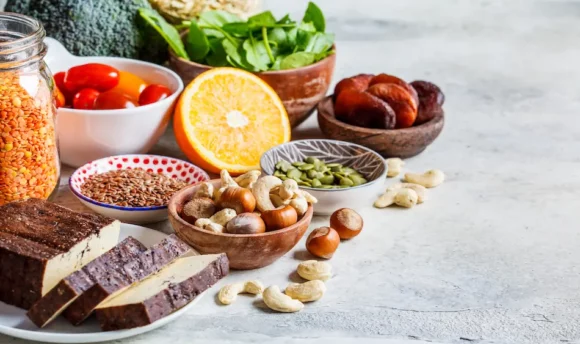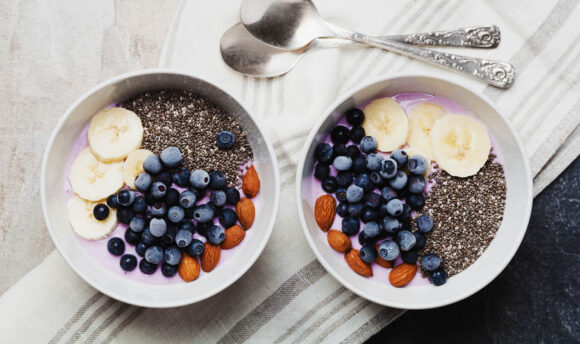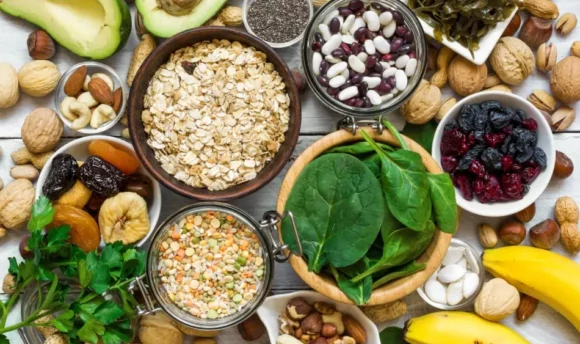9+ Foods High in Magnesium: Top Options for Your Daily Diet
Learn how to nourish your body with healthy high-magnesium foods

As an essential mineral, magnesium plays a variety of important roles in the body. It supports everything from muscle, nerve, and immune function to healthy bones and blood pressure regulation.
Despite this, it’s thought that around half of the US population consumes less than the required amount of magnesium. However, if you’re part of this magnesium deficiency statistic, there are a range of readily available foods that you can eat to up your intake and maintain optimal health.
We’ll explain exactly what they are, how much you should be consuming, and the benefits you could experience from getting the right daily dose of magnesium.
What Is Magnesium?
Getting enough magnesium each day is vital for proper organ and muscle function. Research suggests it also plays an important part in maintaining normal heart rhythm and function to lower the risk of cardiovascular issues.
Magnesium is an essential mineral that plays a crucial role in over 300 enzymatic reactions in the body, including DNA synthesis. It also contributes to the body’s fluid balance, aiding in proper hydration
Without consuming the right amount of this nutrient, you’re at risk of chronic magnesium deficiency, which commonly causes unpleasant symptoms such as convulsions, unusual eye movements, muscle cramping, fatigue, and weakness.
Magnesium dosage
The average adult should consume between 310 and 420 milligrams of magnesium per day to prevent deficiency. However, the exact Recommended Dietary Allowances (RDAs) vary depending on your age and gender as follows:
- 0 to 6 months: 30 milligrams
- 7 to 12 months: 75 milligrams
- 1 to 3 years: 80 milligrams
- 4 to 8 years: 130 milligrams
- 9 to 13 years: 240 milligrams
- 14 to 18 years: 410 milligrams for men, 360 milligrams for women
- 19 to 30 years: 400 milligrams for men, 310 milligrams for women
- 31 years and over: 420 milligrams for men, 320 milligrams for women
Those who are pregnant or breastfeeding may need higher amounts, so consult your doctor to get a personalized recommendation.
Top Foods High in Magnesium
In need of a magnesium boost? Try incorporating some of these natural magnesium sources into your daily meals and snacks:
#1 Seeds and nuts
Along with being packed full of protein, healthy fats, and fiber, nuts and seeds are an excellent source of magnesium. As one of the best natural sources of magnesium, pumpkin seeds come out on top, delivering a huge 592 milligrams, or 140% of the Daily Value (DV) for magnesium.
Try to choose raw varieties where possible, as roasted and salted seeds are often made with added sodium that can contribute to high blood pressure and oils that contain unhealthy saturated fats.
Brazil nuts are the best choice, with 376 milligrams per 100 grams, which is nearly 90% of the DV. However, as they are relatively high in calories, eating too many nuts can increase your risk of obesity and chronic diseases like type 2 diabetes. Sticking to a 30-gram serving, or one handful, is recommended each time.
Here are some other high-magnesium nuts and seeds:
- Sesame Seeds – 351 mg per 100 grams
- Chia seeds – 335 mg
- Sunflower Seeds – 325 mg
- Cashew nuts – 292 mg
- Almonds – 270 mg
- Peanuts – 168 mg
#2 Avocado
As well as containing more potassium than a banana, avocados are high in magnesium, packing in 29 milligrams per 100-gram serving. One fruit also contributes nearly 14% of the Daily Value, so try it on toast or as part of a burrito bowl to increase the magnesium content of your favorite meals.
Avocados are also known for their high monounsaturated fat content, which helps to keep your heart healthy. Studies show that eating just two servings of avocado each week can lower the risk of coronary heart disease by 21%, and cardiovascular disease by 16%.
However, with over 300 calories per fruit, try to eat them in moderation.
#3 Leafy greens
Dark, leafy greens like spinach are often considered to be superfoods as they are highly nutrient-dense and low in calories.
Along with being high in potassium, cooked spinach is packed with vitamins A and K, and also contains 87 milligrams of magnesium per 100 grams. This equates to almost 21% of the Daily Value, making it a great magnesium source for your daily diet.
Many leafy greens are highly versatile, meaning they deliver similar nutrients when eaten raw or cooked. For example, the same portion of raw spinach delivers 79 milligrams of magnesium.
#4 Banana
Despite being most well known for their high potassium content, bananas are also a good source of magnesium.
With 27 milligrams of magnesium per 100 grams, they contribute over 6% of the Daily Value. Eating one large banana per day provides even more magnesium, with nearly 9% of the DV in each fruit.
It’s important to note that ripe bananas contain higher amounts of sugar and carbohydrates than other fruits, making them an unsuitable choice for those on a keto or low-carb diet.
#5 Soybeans
Along with peas, lentils, and chickbeans, soybeans are legumes, a plant packed full of nutrients. They are well known for being a high-iron food, as well as an excellent source of protein for those on a vegetarian diet. Soybeans also deliver 86 milligrams of magnesium or 20% of the DV when cooked.
Fresh soybeans still in the pods, which are known as edamame, are another great option. They can be eaten steamed or boiled, and contain around 64 milligrams of magnesium per 100 grams.
Other soybean products such as tofu make excellent low-fat, plant-based substitutes for meat, while also contributing 58 milligrams to your dietary magnesium intake.
#6 Fatty fish
Varieties of fish like salmon are loaded with heart-healthy omega-3 fatty acids, which are known to lower triglycerides in the blood and reduce the risk of cardiovascular disease.
They’re also full of important vitamins and minerals like magnesium. For instance, mackerel contains a huge 97 milligrams of the nutrient, or 23% of your Daily Value. Halibut and salmon are other great choices, with 26 and 25 milligrams of magnesium in one 100-gram portion, respectively.
#7 Yogurt
If you’re looking for a breakfast or snack option that’s low in calories yet high in magnesium, yogurt is an excellent option. It contains 17 milligrams of magnesium per 100 grams or 4% of the Daily Value.
Yogurt is also high in protein, which keeps you fuller for longer and can help you eat fewer calories throughout the day. This makes it ideal for weight loss, particularly when paired with high-fiber foods like fruits.
Try to choose plain, low-fat varieties like Greek yogurt where possible. Flavored yogurts often contain added sugars, colors, or flavors that boost the overall calorie count.
#8 Dark chocolate
You may be surprised to hear that dark chocolate is a healthy choice in terms of its magnesium content. However, it does contain large amounts of sugar, so try to eat it in moderation as part of a balanced diet.
With 228 milligrams per 100 grams, dark chocolate made with 70 to 85% cocoa contains the most amount of magnesium of all varieties. It is also loaded with plant compounds like flavanols and polyphenols.
These compounds offer antioxidant properties that are great for your heart health and can lower blood pressure.
#9 Whole grains
Whole grains are a much more nutritious option than refined grains, as the bran and germ are still intact. With 64 milligrams per 100 grams, or 15% of the DV, quinoa is one of the best whole-grain sources of magnesium. Quinoa is also a great source of protein, another important nutrient that contributes to healthy muscle function.
Other great whole-grain options include brown rice and oatmeal, which offer 10% and 8.5% of the magnesium DV, respectively.
Health Benefits of Magnesium-Rich Foods
If you’re wondering why you should consider boosting your magnesium intake, here are 3 health benefits of this important nutrient for your brain and body:
#1 Improve sleep quality
If you suffer from insomnia, magnesium supplementation may be able to help. Supplements have been proven to lower the amount of time it takes to fall asleep, while also increasing sleep duration and quality.
Magnesium can improve sleep as it regulates neurotransmitters such as gamma-aminobutyric acid (GABA), which has a natural calming effect on the brain.
#2 Helps to maintain healthy bones
Approximately 50 to 60% of the body’s total magnesium is found in your bones, making it a crucial nutrient for maintaining good bone health. One review found that those with high magnesium intake had increased bone mineral density in the hip and neck areas, both of which are at risk of fracture.
Failing to consume enough magnesium can therefore weaken your bones, with studies linking low levels to brittle bone conditions like osteoporosis.
#3 Promotes digestive health
Magnesium supplements are thought to help ease constipation as they draw water into the intestines, softening stools and making them easier to pass. Research also indicates that they can help to reduce anxiety and stress.
Hard stools and anxiety are both symptoms of irritable bowel syndrome with constipation (IBS-C), so magnesium may be effective in treating this digestive health condition. However, it can cause diarrhea, so isn’t suitable for those struggling with IBS-D.
Magnesium Risks and Side Effects
Magnesium supplements can be highly beneficial for those struggling to meet their daily recommended dose. It may be useful for those with diabetes, gastrointestinal issues like Crohn’s disease, hypertension, or alcohol dependence to take supplements, as these medical conditions can affect absorption.
Certain medications, such as diuretics (water pills) for high blood pressure and proton pump inhibitors (PPIs) that reduce stomach acid, also lower absorption.
However, consuming too much magnesium may cause mild side effects such as stomach cramps and diarrhea. Taking a magnesium supplement in extremely large doses can increase your risk of toxicity, which potentially leads to low blood pressure, irregular heartbeat, breathing difficulties, and cardiac arrest.
Along with magnesium, eating foods high in zinc is essential for maintaining healthy immune function, supporting growth, and healing wounds. However, you should avoid taking magnesium and zinc supplements simultaneously, as this can impact the absorption of both nutrients.
How Can I Raise My Magnesium Quickly Through Diet?
For the majority of healthy adults, it’s possible to get plenty of magnesium through dietary choices alone. There’s no need to drastically overhaul what you eat; making small changes to your daily diet can help boost your intake.
For instance, try swapping your usual candy or potato chip snack for a handful of nuts. Add seeds to your yogurt and banana bowl, and swap refined grains for whole grains like brown rice or quinoa at lunch or dinner.
One way to quickly raise your magnesium levels is to ensure that you’re getting good amounts of vitamin D and calcium in your diet too. You should therefore try to eat plenty of dairy products, leafy green vegetables, and fish, as they can improve magnesium absorption.
A Word From Our RD


If you’re eating a balanced diet filled with plenty of healthy foods like fruits and vegetables, nuts and seeds, fish, and whole grains, you should be able to meet your recommended daily magnesium intake.
However, it may be necessary for some people to take a magnesium supplement, particularly those with medical conditions that reduce the absorption of this essential mineral. There are several different types of magnesium supplements available to choose from.
For instance, while magnesium oxide is most often used to treat deficiency, magnesium citrate is a laxative that relieves constipation. Research indicates that magnesium chloride may help to reduce plasma glucose levels for those with prediabetes. It can also regulate blood sugar and insulin levels, which may contribute to weight loss.
If you’re unsure of which type of magnesium is best for you, or whether you should include a supplement in your daily routine, consult your doctor first.
FAQs
Some of the signs of chronic magnesium deficiency include fatigue, muscle weakness or spasms, cramping, abnormal eye movements, and cramping.
Unlike with dietary supplements, you won’t overdose on magnesium from food. Any excess amounts should be filtered out by the kidneys through your urine.
Taking magnesium supplements is a fast and effective way of increasing levels of this nutrient in the body. However, dietary supplements are not necessary for those with healthy magnesium levels, and should only be taken to correct a deficiency as directed by a doctor. The average person should be able to get a sufficient amount from food sources.
Magnesium supplements are generally safe, but should be avoided by people on certain medications. This includes those taking medications for heart health, antibiotics, or specific diuretics. Always check with your doctor before taking a magnesium supplement.
Conclusion
From supporting bone health to promoting good sleep, magnesium is important for a range of functions. It’s therefore crucial to ensure that you’re getting enough into your daily diet by meeting the Recommended Dietary Allowance for your age and gender, which varies from 310 to 420 milligrams.
Eating a variety of the foods that we’ve mentioned will not only help you to meet this RDA, but will also ensure that you’re consuming a balanced diet filled with plenty of other important nutrients.
Looking for more nutrition tips? Follow @healthreportercom on Instagram for your daily dose of the latest health news and trends.

















































 Select your language:
Select your language: 







